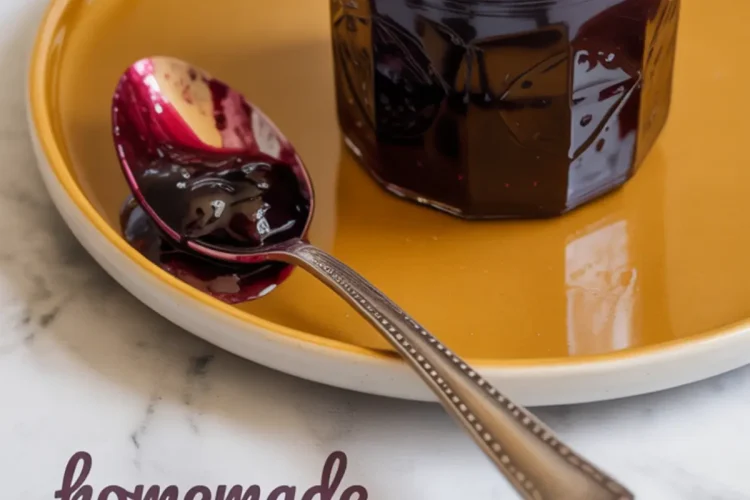Homemade jam feels like summer in a jar, but it doesn’t need to be complicated or time-consuming. This blueberry jam recipe uses just three core ingredients—blueberries, sugar, and lemon juice—and skips commercial pectin entirely.
If you’re after something dependable, beginner-friendly, and worth repeating, you’ve found it. This jam thickens naturally, spreads easily, and stores well. You’ll learn how to make blueberry jam with confidence, using what’s already in your kitchen.
Whether you’ve picked blueberries yourself or grabbed a basket from the market, this recipe helps you preserve that fresh berry flavor with very little fuss.
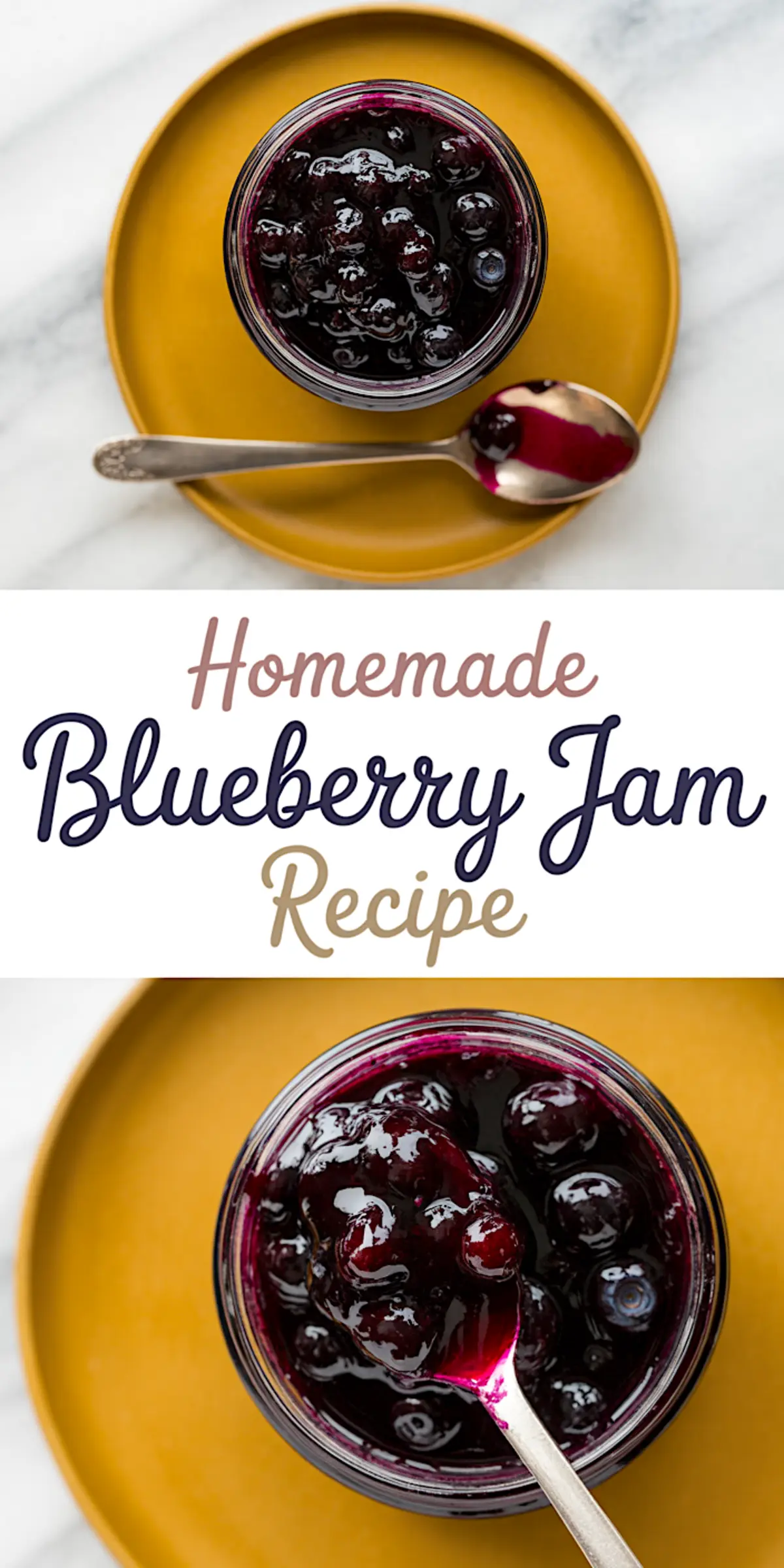
Why This Blueberry Jam Works Every Time
Blueberries contain natural pectin, especially when they’re just ripe. That means you don’t need to add boxed pectin or extra thickeners.
You’ll cook the fruit with sugar and lemon juice long enough to thicken the jam naturally. The result is a balanced spread—sweet, slightly tart, and soft enough to spoon into yogurt or swirl into cake layers.
If you’re looking for a richer flavor, a small amount of vanilla extract can be added at the end of cooking. I’ve used it when pairing this jam with scones or stirred into buttercream. The scent alone is worth it.
This recipe also scales easily. Make a small batch for the fridge or process a larger one using your favorite blueberry jam recipe canning method.
Need another jam idea? Try this Mixed Berry and Vanilla Jam next—it’s a great option if you have leftover fruit on hand.
What You’ll Need to Make This Jam
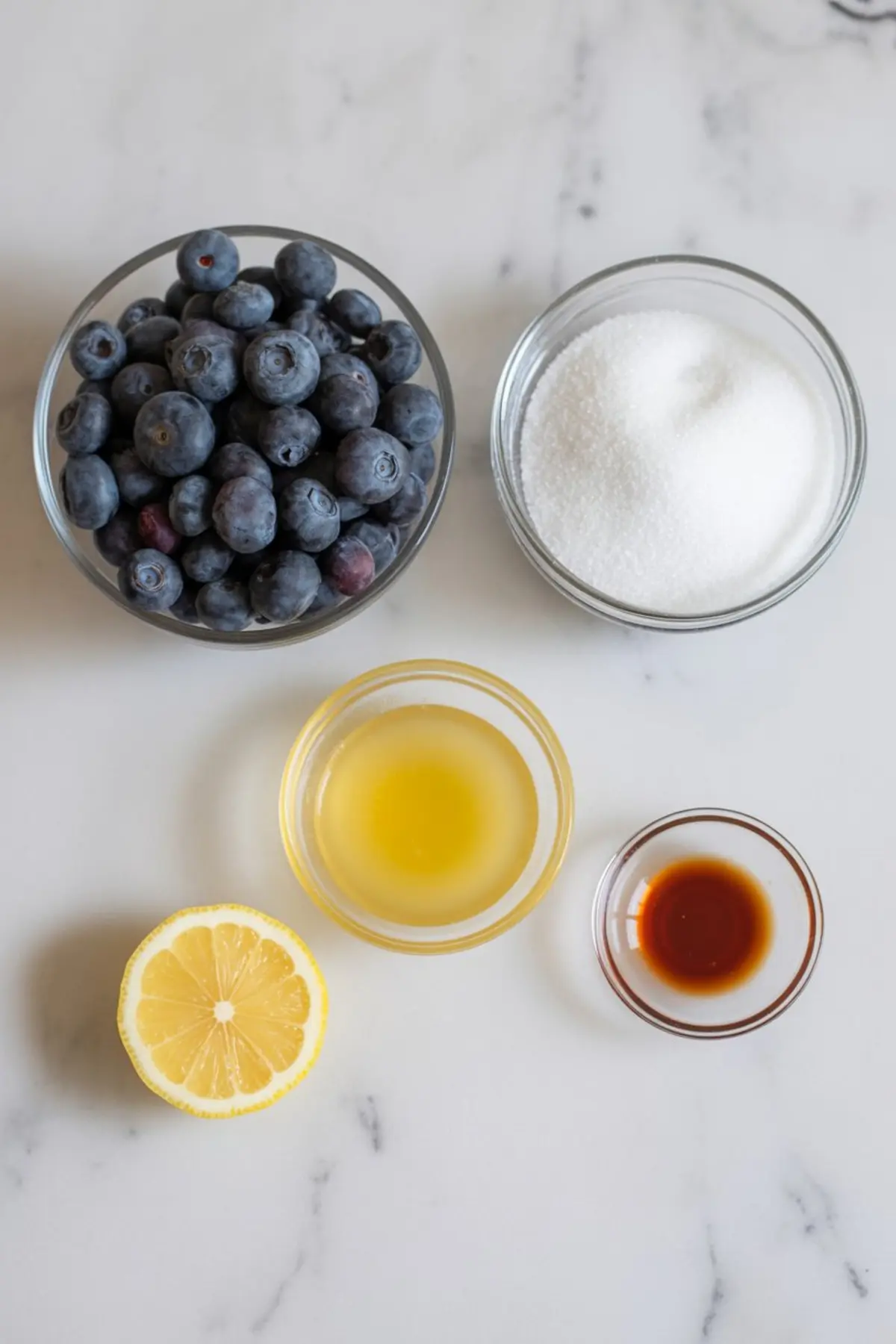
Fresh or frozen blueberries both work well here. If you’re using frozen, you don’t need to thaw them—just toss them into the pot directly.
I always use granulated sugar for consistency. Brown sugar tends to overwhelm the fruit. In my notes, I’ve tried both, and granulated gave the clearest set and cleanest flavor.
Lemon juice helps preserve the jam and enhances the blueberry flavor. Fresh juice is best, but bottled can be used if needed.
A dash of vanilla extract adds warmth. I use it when the jam is destined for toast or dessert fillings, but I skip it when I want a brighter, sharper finish—like in this Homemade Raspberry Jam.
Blueberries vs. Other Berries – What Makes This Jam Unique

I’ve made plenty of berry jams over the years, and blueberries behave differently than raspberries or blackberries. They release less juice at first but thicken more easily because of their pectin content.
Compared to raspberry jam, which often needs longer simmering or extra lemon, blueberry jam sets with less effort.
This makes it one of the best jam recipes homemade beginners can start with—and one that experienced cooks keep in rotation for its reliability.
And if you’re curious about making jam from a mix of berries, you’ll enjoy my Mixed Berry and Vanilla Jam. It’s just as flexible, just as good.
Cooking Tips for Homemade Blueberry Jam
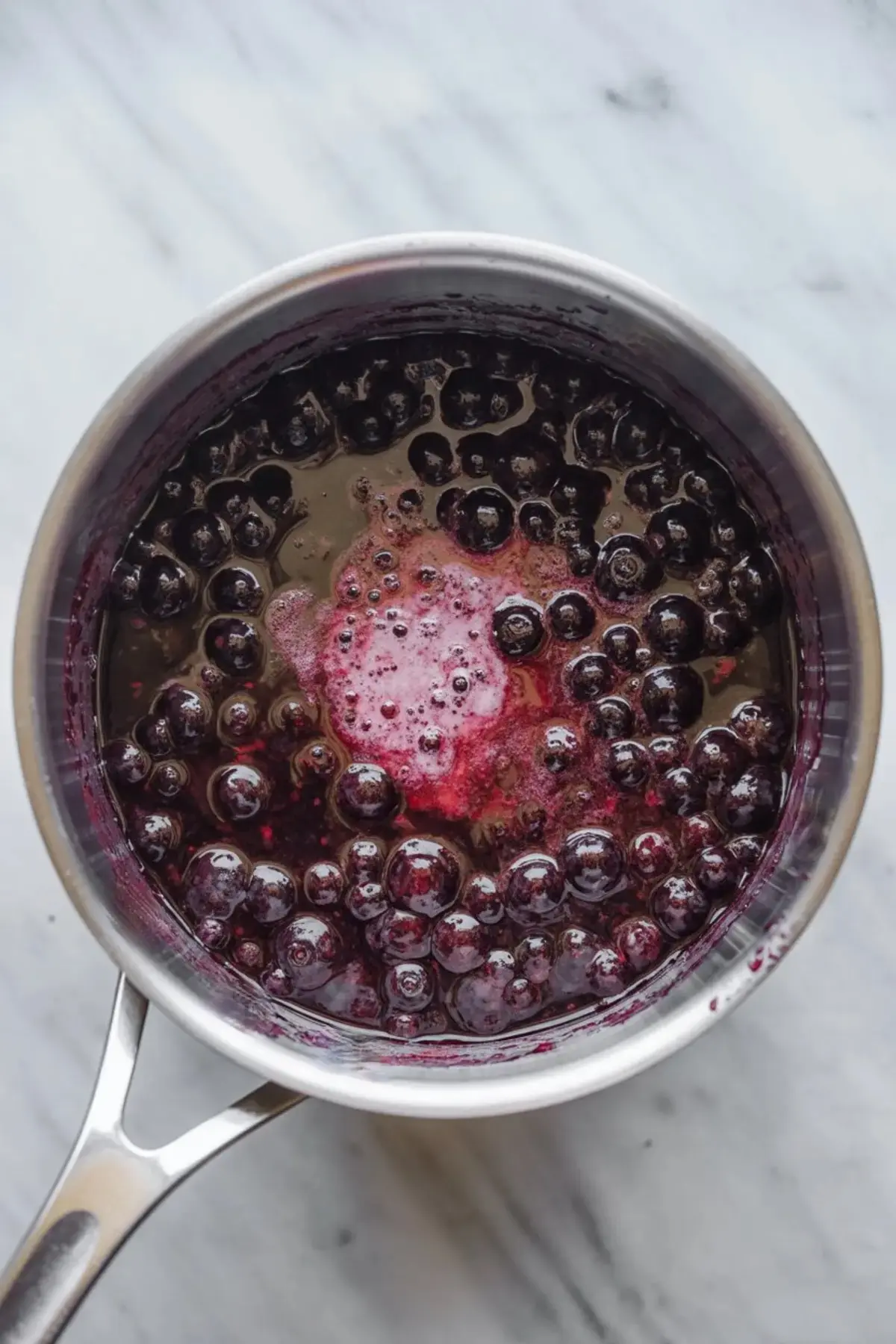
Start by rinsing the berries and removing any soft or shriveled ones. You don’t need to thaw frozen blueberries—just use them straight from the bag.
Combine the blueberries, sugar, and lemon juice in a heavy-bottomed pot. Stir everything until the sugar coats the berries evenly.
Heat the pot over medium and mash the berries gently as they begin to warm up. I use a potato masher, but the back of a large fork also works. Don’t worry about making it completely smooth—texture is part of the charm.
Once the mixture begins to boil, reduce the heat to medium-low. Let it simmer, uncovered, for 20 to 25 minutes. Stir frequently so nothing sticks or burns.
You’ll notice the bubbles thicken and the mixture begin to coat the spoon. That’s a sign it’s nearly done.
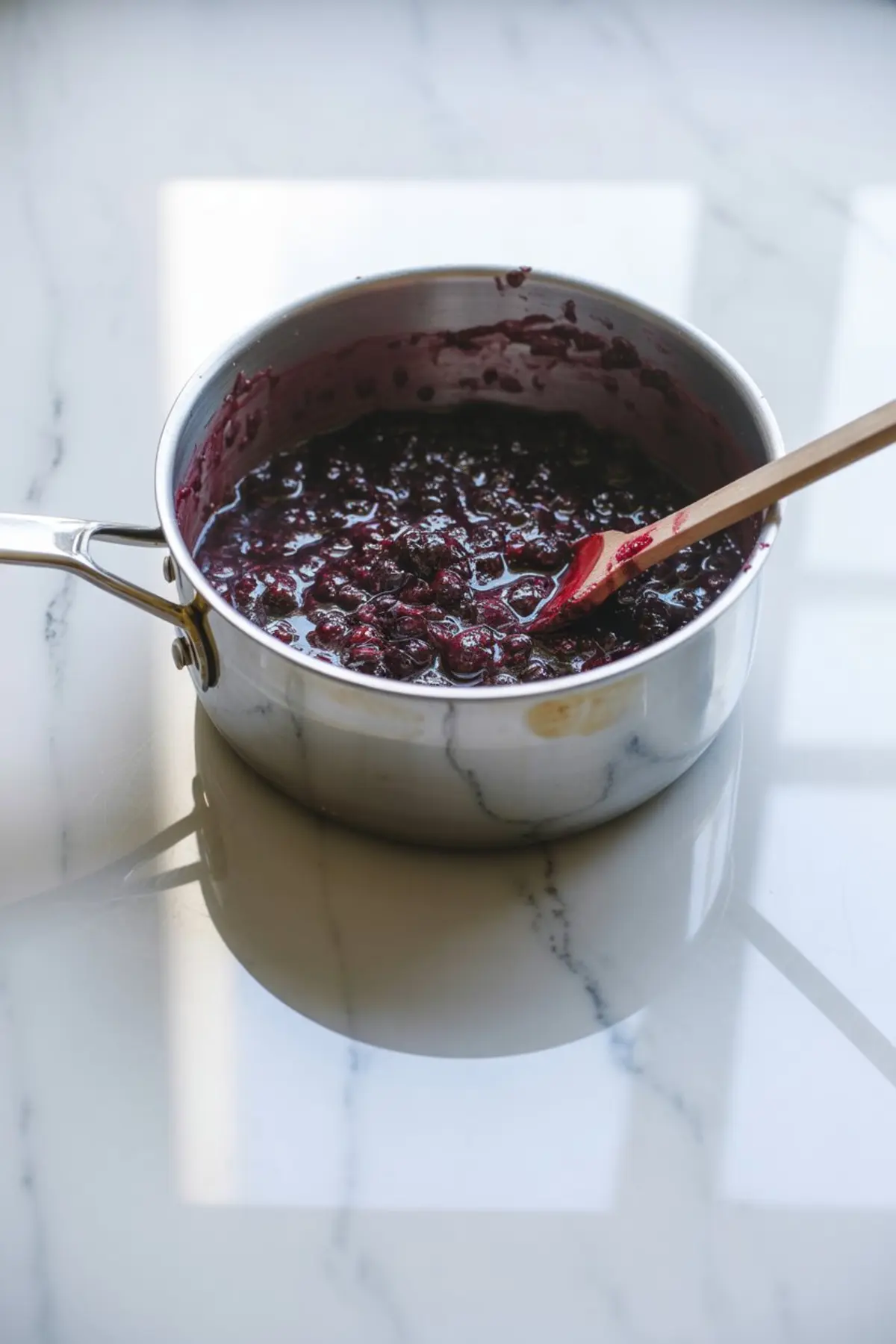
To test doneness, place a small spoonful on a chilled plate. Let it sit for half a minute, then drag your finger through the jam. If the line holds, your jam is ready.
If you want a smoother spread for baked goods or cake fillings, you can blend the berries before cooking. For texture, mash gently and leave some fruit whole.
How to Store and Serve Blueberry Jam
Pour the hot jam into clean jars and wipe the rims. I usually keep a few in the fridge for everyday use and process a couple for pantry storage.
For refrigerator jam, let the jars cool to room temperature before sealing. This version lasts up to 3 weeks chilled.
For shelf-stable storage, use a boiling water bath for 10 minutes. That makes it one of the easiest blueberry jam canning recipes to start with.
This jam spreads beautifully over toast, stirs smoothly into oatmeal, and works as a filling for cakes or cookies.
If you’re looking for fresh blueberry recipes that go beyond jam, I recommend layering it into cheesecake bars or swirling into lemon yogurt. The balance of sweet and tart holds its shape well in bakes.
One Last Thing Before You Jar It
I’ve tested this recipe in small batches, large batches, with and without vanilla, and with both frozen and fresh berries. It’s one of the most forgiving jam recipes I’ve worked with.
It thickens without needing boxed pectin. It holds its color without any tricks. And it tastes like summer—even in February.
Next time you find yourself with extra berries, this is the recipe I’d reach for first.
If you want another fruit-forward option that’s just as satisfying, take a look at this Blueberry Pie recipe—same flavor, different form.
Save and Share Your Blueberry Jam

Pin this blueberry jam recipe to your jam or summer canning board so you can find it again. It’s a staple I always come back to.
Let me know how yours turned out in the comments—did you use vanilla or leave it pure? Did you jar it for winter, or finish the whole batch with toast?
I always enjoy hearing what you make with it.
Blueberry Jam Recipe
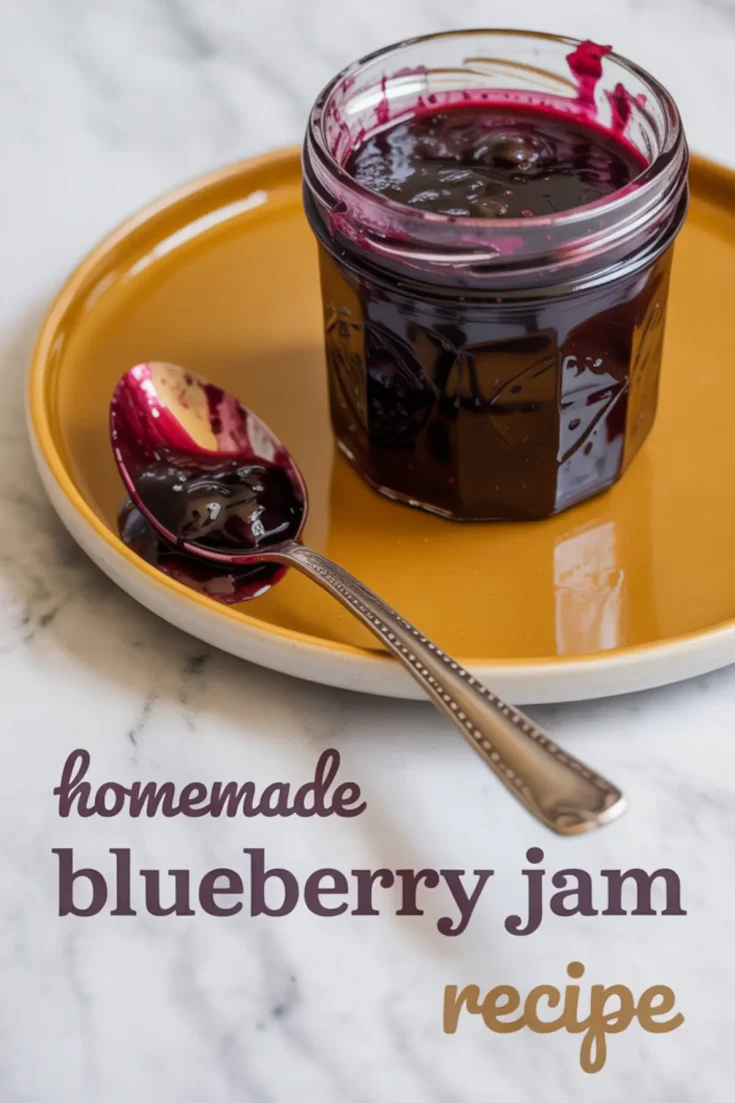
A simple homemade blueberry jam made with just three ingredients: blueberries, sugar, and lemon juice. This small-batch recipe doesn’t use pectin and relies on the natural pectin found in blueberries. The result is a thick, sweet-tart jam that’s perfect for spreading on toast, adding to yogurt, or using in baked goods.
Ingredients
- 4 cups fresh or frozen blueberries
- 1 ½ cups granulated sugar
- 2 tablespoons freshly squeezed lemon juice
- ½ teaspoon vanilla extract (optional)
Instructions
- PREPARE THE FRUIT: Rinse the blueberries thoroughly, removing any stems or soft berries. If using frozen blueberries, no need to thaw—add them directly to the pot.
- COMBINE INGREDIENTS: In a large, heavy-bottomed saucepan, mix the blueberries, sugar, and lemon juice. Stir until the berries are well-coated with sugar.
- MASH AND COOK: Place the pan over medium heat. Use a potato masher or fork to mash the berries as they begin to heat up. Continue mashing until most of the berries have broken down. Bring the mixture to a gentle boil.
- SIMMER TO THICKEN: Reduce the heat to medium-low and let the jam simmer uncovered for 20 to 25 minutes. Stir frequently with a heatproof spatula or wooden spoon to prevent sticking. The jam will begin to thicken as the liquid evaporates.
- TEST FOR DONENESS: To check if the jam is ready, place a small spoonful on a chilled plate and let it sit for 30 seconds. Drag your finger through it—if the line holds and doesn’t run back together, the jam is done.
- OPTIONAL FLAVOR BOOST: If using vanilla extract, stir it in after removing the jam from the heat. Mix well to combine.
- FILL AND SEAL JARS: Carefully pour the hot jam into sterilized jars, leaving ¼ inch of headspace at the top. Wipe the rims clean, apply the lids, and let cool to room temperature. Store in the refrigerator for up to 3 weeks, or process in a water bath for shelf-stable storage.
Notes
For smoother jam, blend the blueberries before cooking. To make the jam shelf-stable, process filled jars in a boiling water bath for 10 minutes.
Nutrition Information
Yield
3Serving Size
1Amount Per Serving Calories 496Total Fat 1gSaturated Fat 0gTrans Fat 0gUnsaturated Fat 1gCholesterol 0mgSodium 6mgCarbohydrates 126gFiber 6gSugar 118gProtein 1g

